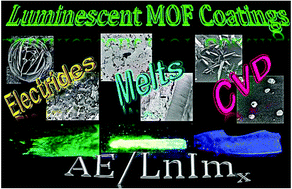Organic melt, electride, and CVD induced in situ deposition of luminescent lanthanide imidazolate MOFs on nanostructured alumina†
Abstract
The highly luminescent MOFs 3∞[Ce(Im)3ImH]·ImH, 3∞[Tb(Im)3], and the dense framework 3∞[Sr0.95Eu0.05(Im)2] (Im− = imidazolate-anion, C3N2H3−) were grown on nanostructured macroporous aluminium oxide (AAO) membranes. Thereby, luminescent coatings on the membranes were achieved. Three different growth processes unusual for MOFs were investigated and compared: a film growth process in situ to MOF formation from the linker melt, electride induction with solvated electrons, and chemical vapour deposition (CVD) to additionally utilize the gas phase. Deposition from the organic melt has proved to be a fast approach to achieve various film thicknesses of the luminescent frameworks. The electride-based approach offers excellent homogenization at an atomic level for the highest quantum yields of QY > 90% for 3∞[Sr0.95Eu0.05(Im)2] including the formation of barite rose analogous crystals prior to growth of a complete film on AAO membranes. For 3∞[Tb(Im)3] and 3∞[Ce(Im)3ImH]·ImH, deposition of bundles of crystals by CVD on AAO is possible while also maintaining the luminescence of the original MOFs but without complete layers. In order to elaborate the divalent character of europium, being the basis of the high efficiency of the luminescence, EPR studies were carried out on 3∞[Sr1−xEux(Im)2], x = 0.01, 0.05 and 1.

- This article is part of the themed collections: HOT articles in Inorganic Chemistry Frontiers for 2015 and Crystal engineering for molecular materials

 Please wait while we load your content...
Please wait while we load your content...